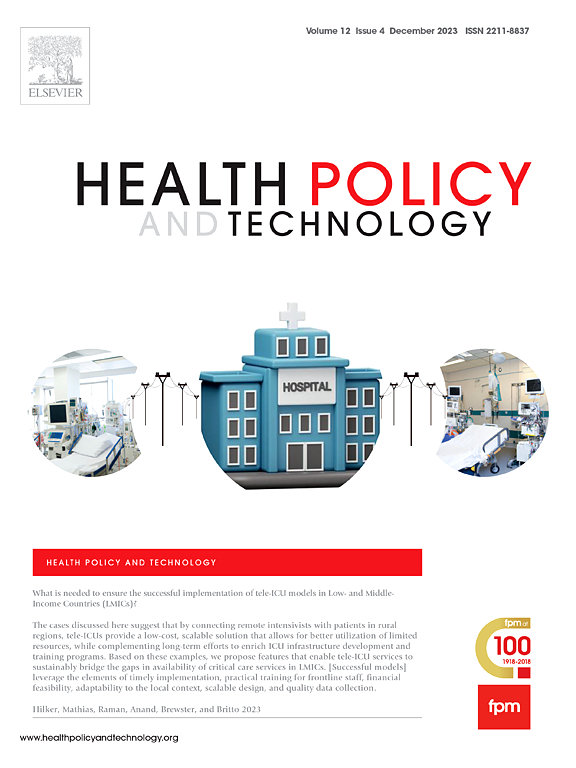预测COVID-19期间医疗保健服务的利用——基于常规数据的预测模型
IF 3.7
3区 医学
Q1 HEALTH POLICY & SERVICES
引用次数: 0
摘要
COVID-19大流行通过对COVID-19病例的优先排序和资源的重新分配,例如导致选择性程序的推迟,对全球卫生保健系统产生了重大影响。本研究量化了2020年和2021年COVID-19大流行对医疗保健利用的影响。方法使用2013年至2019年大流行前的数据对预测模型进行训练。使用最合适的模型来预测两个大流行年份中不受大流行影响的医疗保健利用趋势。观察到的利用率与预测的利用率之间的偏差被解释为大流行对医疗保健的影响。结果在COVID-19大流行期间,前三波全因住院率下降。第一次下降发生在2020年4月,住院率降至大流行前预期水平的1.7倍。第二次下降始于2020年11月,到2021年1月比预期水平低1.4倍。在严格的封锁措施放松后,住院率恢复到大流行前的水平。这些下降不仅影响选择性手术,也影响危及生命的疾病,如心肌梗死(MI)。2020年3月和4月,这些活动的入场人数比预期水平低1.29倍。然而,到2020年7月,心肌梗死住院率增加,达到大流行前典型住院率的0.87倍。我们首次使用现代预测方法调查了大流行对德国医疗保健的影响,该方法显示了心肌梗死等急性疾病的延迟住院。研究结果强调了保护弱势群体的必要性,并强调了进一步研究长期健康影响和改善公共卫生反应的重要性。COVID-19大流行将COVID-19病例置于其他疾病之上,严重扰乱了医疗保健服务,导致干预措施推迟,并减少了对心肌梗死等严重问题的护理。本研究通过比较观察到的住院情况与基于2013-2019年大流行前趋势的预测值,调查了2020-2021年德国的医疗保健利用情况。结果显示,在前三波大流行期间,住院人数急剧下降。2020年4月,住院人数降至预期水平的近一半,并在2020年底出现第二次下降。只有在封锁措施解除后,关系才开始正常化。至关重要的是,因心肌梗塞等危及生命的疾病入院的人数也暂时下降,显示出住院人数的时间差。这一分析强调,即使在大流行时期,也必须确保重症患者获得医疗保健,以减少对健康的负面影响,并提高医疗保健在未来危机中的复原力。本文章由计算机程序翻译,如有差异,请以英文原文为准。
Predicting the utilization of healthcare services during COVID-19 - forecasting models based on routine data
Background
The COVID-19 pandemic has significantly impacted global healthcare systems through the prioritisation of COVID-19 cases and the reallocation of resources, leading, for example, to a postponement of elective procedures. This study quantifies the impact of the COVID-19 pandemic on healthcare utilization in 2020 and 2021.
Methods
Forecasting models were trained using data from the pre-pandemic years 2013 to 2019. The most suitable model was used to predict a trend in healthcare utilization unaffected by the pandemic in the two pandemic years. Deviations between observed and predicted utilization were interpreted as the pandemic impact on healthcare.
Results
During the COVID-19 pandemic, all-cause hospitalizations declined across the first three waves. The first drop occurred in April 2020, with hospitalization rates falling to 1.7 times below expected pre-pandemic levels. A second drop began in November 2020, reaching 1.4 times below expected levels by January 2021. Hospitalizations returned to pre-pandemic levels after strict lockdown measures eased. These declines affected elective procedures but also life-threatening conditions, such as myocardial infarctions (MI). In March and April 2020, admissions for these events were 1.29 times below expected levels. By July 2020, however, MI hospitalization increased, reaching 0.87 times higher than typical pre-pandemic rates.
Discussion
We investigate for the first time the impact of the pandemic on healthcare in Germany using modern forecasting methods showing delayed hospitalizations for acute conditions like MI. Findings highlight the need to protect vulnerable groups and underscore the importance of further research on long-term health impacts and improved public health responses.
Lay summary
The COVID-19 pandemic has significantly disrupted healthcare provision by prioritising COVID-19 cases over other conditions, leading to postponement of interventions and reduced care for serious problems such as myocardial infarctions (MI). This study examined healthcare utilization in Germany in 2020–2021 by comparing observed hospitalisations with predicted values based on pre-pandemic trends from 2013–2019. The results showed a sharp decline in hospitalisations during the first three pandemic waves. In April 2020, hospital admissions fell to almost half the expected level, with a second decline at the end of 2020. Normalisation only set in when the lockdown measures were lifted. Crucially, admissions for life-threatening conditions such as MI also fell temporarily, showing a time lag in hospital admissions. This analysis emphasises the importance of ensuring access to healthcare for critical illnesses, even in times of pandemic, to reduce negative health impacts and improve the resilience of healthcare in future crises.
求助全文
通过发布文献求助,成功后即可免费获取论文全文。
去求助
来源期刊

Health Policy and Technology
Medicine-Health Policy
CiteScore
9.20
自引率
3.30%
发文量
78
审稿时长
88 days
期刊介绍:
Health Policy and Technology (HPT), is the official journal of the Fellowship of Postgraduate Medicine (FPM), a cross-disciplinary journal, which focuses on past, present and future health policy and the role of technology in clinical and non-clinical national and international health environments.
HPT provides a further excellent way for the FPM to continue to make important national and international contributions to development of policy and practice within medicine and related disciplines. The aim of HPT is to publish relevant, timely and accessible articles and commentaries to support policy-makers, health professionals, health technology providers, patient groups and academia interested in health policy and technology.
Topics covered by HPT will include:
- Health technology, including drug discovery, diagnostics, medicines, devices, therapeutic delivery and eHealth systems
- Cross-national comparisons on health policy using evidence-based approaches
- National studies on health policy to determine the outcomes of technology-driven initiatives
- Cross-border eHealth including health tourism
- The digital divide in mobility, access and affordability of healthcare
- Health technology assessment (HTA) methods and tools for evaluating the effectiveness of clinical and non-clinical health technologies
- Health and eHealth indicators and benchmarks (measure/metrics) for understanding the adoption and diffusion of health technologies
- Health and eHealth models and frameworks to support policy-makers and other stakeholders in decision-making
- Stakeholder engagement with health technologies (clinical and patient/citizen buy-in)
- Regulation and health economics
 求助内容:
求助内容: 应助结果提醒方式:
应助结果提醒方式:


